In the diverse world of bird species, many birds exhibit unique characteristics and behaviors that captivate bird enthusiasts and researchers alike. From the majestic eagles soaring high in the skies to the colorful parrots adorning tropical forests, most bird species play vital roles in their ecosystems.
While some birds, like the kiwis of New Zealand, showcase distinctive traits such as flightlessness and keen senses, other birds, such as robins frequenting gardens, bring joy with their cheerful presence.
Exploring avian life reveals various adaptations and behaviors across most species. Join us on a journey to discover the wonders of the avian world and delve into the remarkable diversity that defines our feathered friends.
Woodpecker
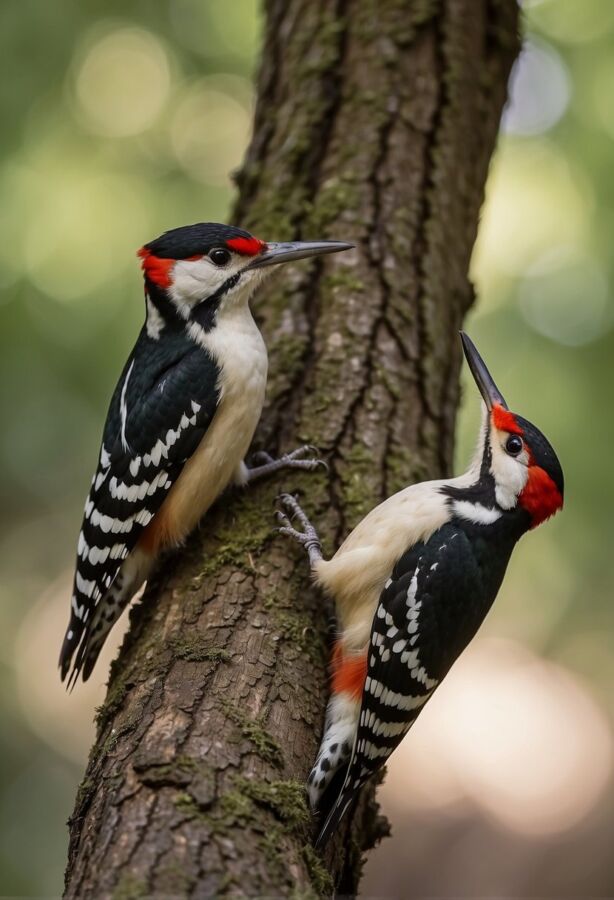
In North America, woodpeckers encompass 23 species, each exhibiting unique behaviors and physical characteristics. These birds, known for their pecking habit, play a vital role in ecosystems by controlling insect populations and creating habitats for other species through their nesting cavities.
Notable Species:
- Red-headed Woodpecker: Distinguished by its bright crimson head, commonly found in eastern and central U.S. woodlands.
- Pileated Woodpecker: Among the largest, recognizable by its black body and striking red crest.
- Downy Woodpecker: The continent’s smallest woodpecker, sporting a black and white plumage.
Conservation Status:
- The Red-cockaded Woodpecker is one species facing habitat loss, making its conservation critical for ecosystem balance.
Woodpeckers’ characteristics include:
| Trait | Description |
| Beak | Chisel-like, adapted for boring into wood |
| Tongue | Long, sticky, and barbed for extracting insects |
| Tail | Stiff feathers for support while climbing trees |
Most woodpecker species are widespread and easily sighted, but habitat destruction threatens some. This makes proactive conservation measures necessary to ensure these birds’ survival and the health of their habitats.
Pigeon

The pigeon, a member of the bird family Columbidae, displays an impressive range of size and color across its numerous species. Pigeons are renowned for their exceptional homing ability, particularly the Homing Pigeon, which can navigate back to its nest from far distances. Historically, these birds served as messengers due to this innate skill.
| Common Types of Pigeons | Notable Traits |
| Homing Pigeon | Navigational proficiency |
| Rock Pigeon (City Pigeon) | Ubiquitous in urban areas |
| White Domestic Pigeon | Symbolizes peace |
The family includes both terms, “pigeons” and “doves,” with distinctions often linguistically rather than taxonomically derived; the smaller species tend to be called doves. Pigeons have a worldwide presence, excluding extreme cold regions and isolated islands. Conservation efforts focus on habitat preservation to support the diversity within the Columbidae family.
Peacock

Peafowl, commonly known as peacocks, are a group of bird species known for their ornate plumage and striking presence. They belong to the Phasianidae family, which also includes pheasants and their kindred.
- Species: There are three main species:
- Indian Peafowl (Pavo cristatus), native to India and Sri Lanka, is known for its iridescent blue and green plumage.
- Green Peafowl (Pavo muticus), found from Myanmar to Java, showcasing green and gold feathers.
- Congo Peafowl (Afropavo congensis) is found in the Congo Basin and has less flamboyant colors.
Male peafowls, known as peacocks, display elaborate fan-shaped tail feathers adorned with ‘eyes’ used in courtship rituals. The Indian Peafowl is listed as “Least Concern,” but the Green Peafowl is designated as “Endangered,” highlighting the species’ varying conservation needs. Supporting their habitats is crucial to ensuring their survival.
Rooster

Roosters, the male counterpart of chickens, play a pivotal role in the avian world. They serve as symbols of rural life and natural alarm clocks with their signature crowing at dawn.
Popular Breeds:
- Rhode Island Red: Known for their protectiveness.
- Plymouth Rock: Renowned for reliability and calmness.
- Leghorn: Esteemed for their exceptional egg-laying.
- Silkie: Distinct for their fluffy plumage.
- Brahma: Notable for their large size and gentle nature.
Roosters exhibit diverse temperaments, from the assertive to the docile. Some are kept for practical purposes, such as breeding and flock protection, while others are valued for ornamental appeal. Conservation of heritage breeds is crucial as it maintains genetic diversity within domesticated birds.
Vulture

Vultures are carrion-eating birds grouped into two families: the Accipitridae (Old World vultures) and the Cathartidae (New World vultures). Approximately 23 recognized vulture species globally serve vital ecological roles by consuming dead animal matter, reducing disease spread.
Old World Vultures (Accipitridae)
- Bearded Vulture (Gypaetus barbatus)
- Griffon Vulture (Gyps fulvus)
- Indian Vulture (Gyps indicus)
New World Vultures (Cathartidae)
- Not specifically listed in the provided data
Vultures are characterized by their bald heads, a feature thought to aid in hygiene while feeding. They possess exceptional flying capabilities, with some species, like the Bearded Vulture, having wingspans exceeding 9 feet. They have keen eyesight for detecting food over vast distances and strong stomach acids that neutralize toxins from decaying carcasses.
Their conservation status varies widely. For example, the White-rumped Vulture is critically endangered due to habitat loss, poisoning, and declining food availability. Conservation efforts are essential to preserve these birds, which play an important role in maintaining healthy ecosystems.
Vultures also exhibit fascinating behaviors; for example, Bearded Vultures are known to stain their feathers with red soil, a phenomenon believed to be related to social status among the species. Additionally, their adaptations span from sharp eyesight to stomach acids capable of digesting even bones, exemplifying their evolutionary prowess as scavengers.
Swallow

Swallows are a group of birds found in the family Hirundinidae, characterized by their streamlined bodies and long, pointed wings, allowing proficient aerial maneuvers. As experts in catching insects mid-flight, these birds are aerial insectivores.
Common Species:
- Barn Swallow
- Bank Swallow
- Tree Swallow
Swallows differ from swifts, though both exhibit aerial feeding; swifts have crescent-shaped wings and a body adapted for a more rapid flight.
Conservation Status:
- While currently widespread, the barn swallow faces potential threats from habitat loss and is monitored for changes in conservation status.
Swallows are a definitive sign of summer in many temperate regions, and birdwatchers eagerly anticipate their arrival.
Seagull

Seagulls, members of the family Laridae and genus Larus, encompass around 50 species found worldwide. Despite their common moniker, “seagulls,” they often inhabit coastal and inland areas, ranging from oceans to bogs.
Distribution and Habitat
- Coastal regions
- Inland waters
- Bogs
Physical Characteristics
- Size: Varies; some similar to a herring gull
- Color: Typically pale grey upperparts, white head (summer), streaked head (winter)
- Legs: Pink in adults
Feeding Habits
- Omnivorous diet
- Eats fish, crustaceans, human leftovers
Conservation Status: Most are of Least Concern, indicating a stable population.
Interesting Fact: Gulls are agile in different terrains – adept at flying, swimming, and walking.
Quail

Quail are small, ground-dwelling birds recognized for their distinctive calls and camouflage abilities. The species are divided into two broad categories:
Old World Quail (Family: Phasianidae)
- Subfamilies: Phasianinae or Perdicinae
- Approximate species count: 95
- Characteristics: Generally smaller and less robust than partridges
New World Quail (Family: Odontophoridae)
- Notable species: Northern bobwhite, California quail
- Habitual features: Ground-dwelling with varied diets
Distinctive Features:
- Size: Small to medium
- Tail: Short-tailed
- Diet: Varied (seeds, insects, etc.)
Quail is important for ecosystem balance and faces conservation challenges like habitat loss. Knowledge about these birds aids in creating effective conservation strategies to ensure their survival and well-being.
Duck

Ducks are waterfowl birds known for their distinctive waddle and quacking sound. Belonging to Anatidae, ducks are smaller than their relatives, swans and geese. They can be found in both freshwater and seawater environments across the globe. Here’s a brief overview of these birds:
- Habitat: Ducks inhabit various wetlands, including marshes, ponds, rivers, and oceans.
- Feeding Habits: Many species are dabbling ducks, feeding at the water’s surface rather than diving.
- Reproduction: Typically, they build nests on the ground and are known for their colorful eggs.
Diverse in kind, ducks have several species adapted to specific habitats and climates. Conservation of ducks is vital due to habitat loss and hunting pressures. Protecting their environments ensures the survival of both domestic and wild species.
Pelican
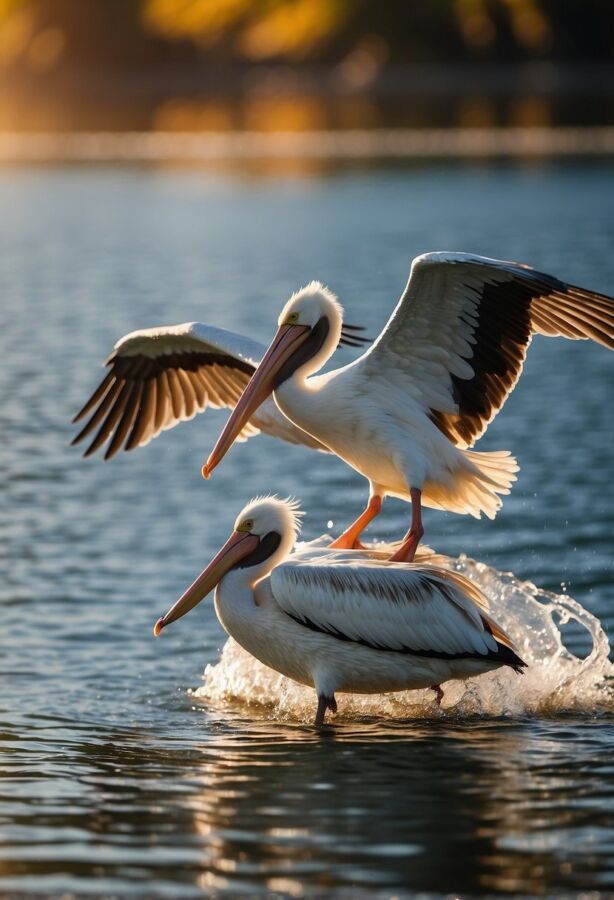
Pelicans are a genus of large water birds comprising eight species. Characterized by their elongated beaks and sizeable throat pouches, pelicans use this anatomy to catch and drain water from their prey before swallowing. They frequent environments close to lakes, rivers, and seas, as their diet primarily consists of fish.
- Appearance: Pelicans display a vivid spectrum of colors, from the stark white plumage of the American White Pelican to the dusky complexion of the Brown Pelican.
- Feeding Habits: A pelican’s pouch is integral for capturing fish and cooling itself by fluttering it to lose heat.
Pelicans are graceful in flight, and groups often fly in formation, providing a captivating sight. Despite their robust size, pelicans are relatively buoyant thanks to air sacs beneath their skin. This feature and their cooperative hunting strategies make them proficient hunters and survivors in their watery realm.
Cardinal

Cardinals, renowned for their vivid hues and melodious calls, are a diverse group of songbirds captivating bird enthusiasts. The Northern Cardinal, perhaps the most recognized, flaunts a brilliant red coloration, while females bear a more subdued shade with hints of red. Cardinals are non-migratory, tending to reside within a fixed territory year-round.
Key Species
- Northern Cardinal (Cardinalis cardinalis): Iconic bright red plumage found extensively across North America.
- Vermilion Cardinal (Cardinalis phoeniceus): Exhibits a striking red body endemic to Colombia and Venezuela.
Conservation
Their population is considered stable, yet habitat loss and window collisions pose threats. Mitigating these issues is pivotal for their sustained visibility in urban and suburban landscapes.
Unique Attributes
- Coloration: Sexual dimorphism is evident, with males being more vibrantly colored.
- Song: Complex whistles, often territorial.
Distribution
- North America: Primarily Eastern USA and Mexico.
- South America: Limited to specific regions like Northern Colombia.
By maintaining habitats and supporting conservation efforts, we help ensure that the cardinals continue to thrive, allowing future generations to behold their splendor.
Pheasant
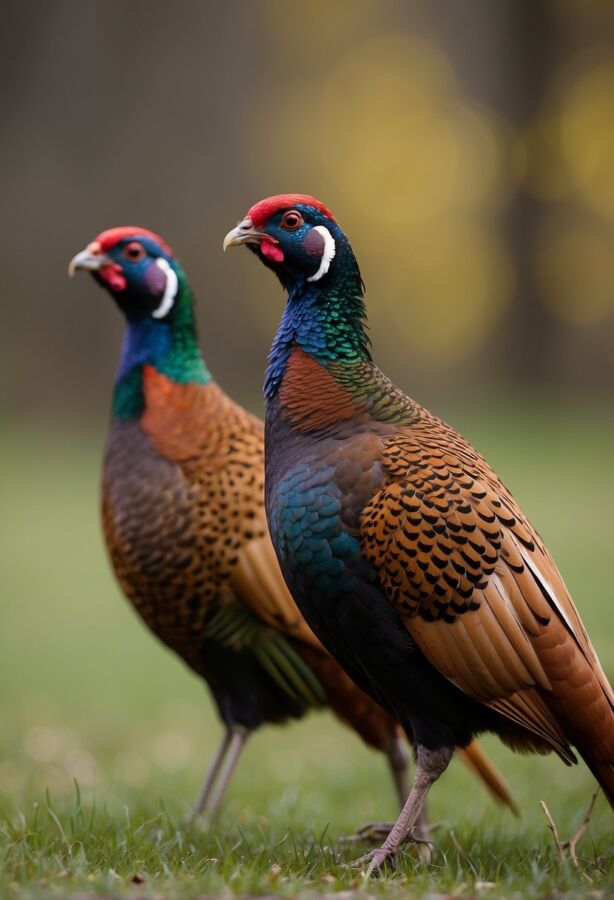
Pheasants are a distinctive group of birds belonging to the family Phasianidae. Species within this family are known for their exquisite plumage. They are often found in open woodlands and fields, primarily in Asia. One species, the Common Pheasant, is also widespread in North America and Europe.
- Common Pheasant: Characteristic for its colorful males with blue-green heads and white neck rings, whereas females sport a subtler brown plumage.
- Reeves’s Pheasant: Notable for extremely long tail feathers and bold patterns.
Conservation Status:
While some pheasant species enjoy stable populations, others are threatened by habitat loss and hunting. The IUCN lists species like the Reeves’s Pheasant as vulnerable, highlighting the importance of conservation efforts.
Pheasants typically feed in small flocks and display elaborate mating rituals in their natural habitats. They play a vital role in their ecosystems as seed dispersers and prey for larger predators.
Spoonbill
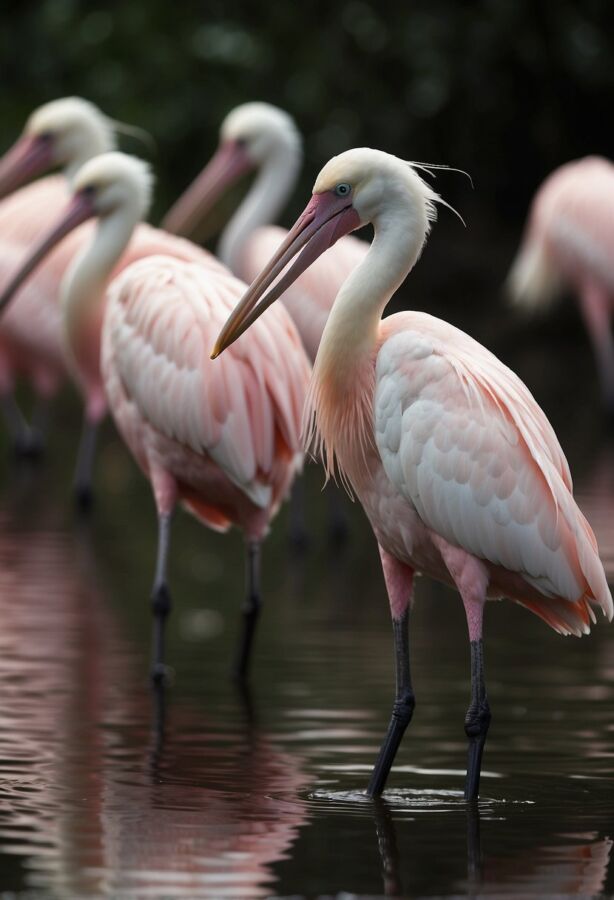
Spoonbills are a group of large, long-legged, wading birds characterized by a distinct spoon-shaped bill. They are found in regions ranging from Europe to Japan and also inhabit North Africa. Spanning six species, spoonbills are most notable for their peculiar bills, which are instrumental in their feeding technique.
Key Characteristics
- Bill Shape: Their bills are narrow, elongated, and flat, expanding into a spoon shape at the end, essential for sifting through water.
- Habitat: They frequent fresh and saline shallow waters, thriving in wetlands and estuaries.
Feeding Habits
- Foraging: They feed by wading through the water, swinging their heads to scoop up prey like crustaceans and fish.
The spoonbills’ conservation status varies among species, with some being under threat due to habitat loss and pollution. Protecting their wetland habitats is critical for their survival.
Puffin

Puffins belong to the Alcidae family, like auks. These medium-sized birds are identified by their boldly colored bills and stout build. Their plumage is primarily black and white, and they possess comparatively short wings, aiding their underwater hunting prowess.
- Nesting: They typically nest in cliffside colonies.
Species
Puffins are classified into several species:
- Atlantic Puffin: Notable for the blue triangle at its beak’s base.
- Tufted Puffin
- Horned Puffin
- Rhinoceros Auklet (often considered a puffin species)
Conservation:
The Atlantic Puffin is classified as vulnerable, largely due to overfishing and climate change, while other puffin species are listed as least concern.
These birds are ocean-dwellers, adept at flying and swimming, with their diet primarily consisting of fish. Despite their skill in water, puffins spend considerable time on land during breeding seasons, where they are known to be social creatures, forming large nesting colonies.
Magpie
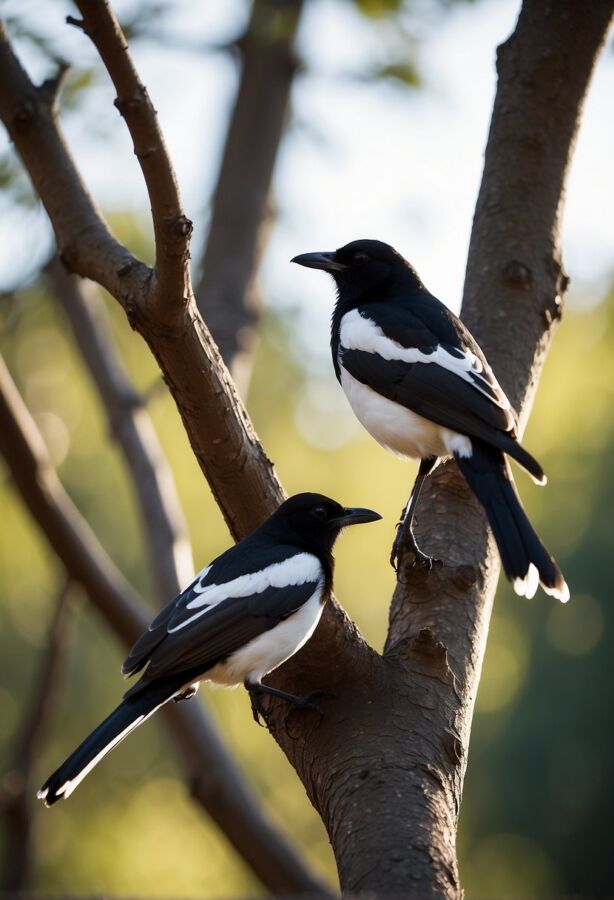
Magpies are highly intelligent birds belonging to the Corvidae family. They are recognized for their striking black and white plumage and long tails. The genus Pica houses several species, including the Eurasian magpie (P. pica) and the black-billed magpie (P. hudsonia).
They are omnivorous, foraging for fruits, seeds, and insects. Magpies exhibit complex social behavior and can mimic sounds within their environment. Most magpie species are of least concern, but habitat loss and changes impact specific populations.
Parrot
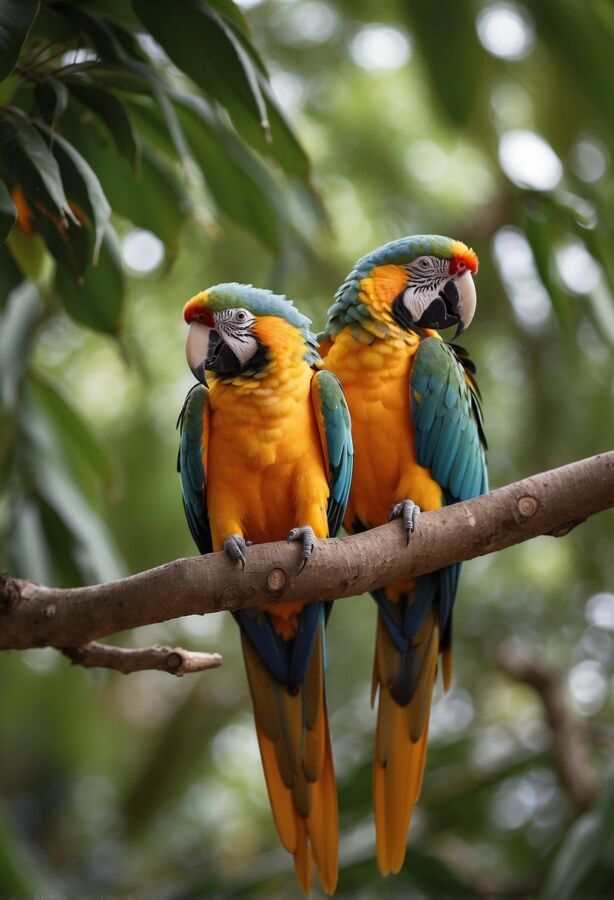
Parrots, comprising the order Psittaciformes, are diverse birds known for their vivid colors, robust beaks, and species that range over tropical and subtropical regions. Estimates suggest there are around 400 species of parrots, each adapting uniquely to their habitats.
Many parrot species have become popular pet birds due to their sociability, intelligence, and ability to mimic human speech. Notable pet-friendly species include:
- Budgerigars: Small, amicable; ideal for beginners.
- Cockatiels: Affectionate, with a distinctive crest.
- Lovebirds: Known for their playful, energetic nature.
While some parrots adapt well to domestic life, others, like large macaws and certain cockatoos, require more experience due to their complex care needs.
Many parrot species face threats from habitat loss and the pet trade, leading to a precarious conservation status for some. Efforts are ongoing to protect these charismatic birds through legal protections and conservation programs.
Turkey

Turkey is home to diverse bird species, including the prominent wild turkey (Meleagris gallopavo) and the ocellated turkey (Meleagris ocellata). Birds in Turkey are varied, from aquatic Anatidae like ducks, geese, and swans, to terrestrial Phasianidae such as pheasants and grouse.
- Wild Turkey: Predominantly found in North America, noted for the male’s distinctive fleshy wattle called a snood.
- Ocellated Turkey: Natives to the Yucatán Peninsula, these birds display striking iridescent feather patterns.
The Eurasian Blackbird is among the most noticeable in Turkey, thriving in gardens and parks. Bird conservation efforts are vital due to habitat loss and other environmental pressures. Admire the ability of Anatidae members to shed water with their oily-coated feathers, an evolutionary marvel facilitating their aquatic lifestyle.
Crane
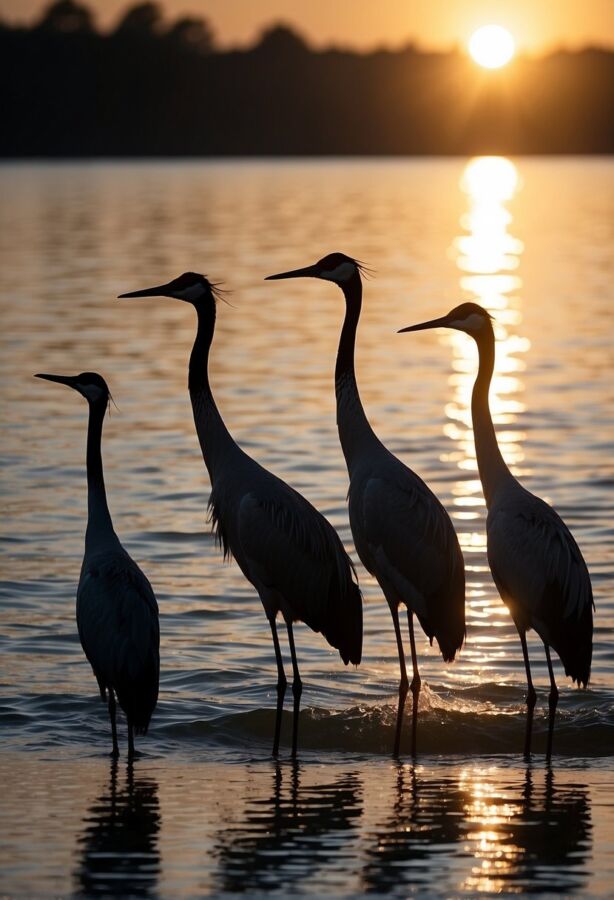
Cranes are majestic birds distinguished by their long legs and necks, which facilitate foraging in various habitats, from wetlands to grasslands. Crane species are known for their elaborate mating dances, characterized by bowing and leaping movements and stunning displays of their courtship rituals.
These bird types stand out for their tapered bodies and long secondary feathers, emphasizing their graceful appearance. Some crane species boast vibrant plumage, adding to their visual allure.
Cranes face pressure from habitat loss and degradation. Of 15 known species, several are classified as endangered by the IUCN. Initiatives to protect their habitats are crucial for their continued survival.
Kingfisher

The Kingfisher family comprises vibrant birds known for their fishing prowess, darting into the water to catch prey. Three families—Alcedinidae, Halcyonidae, and Cerylidae—encompass around 90 species. These birds flaunt a hefty bill, perfect for fishing, and their habitat ranges globally, primarily in tropical regions.
North America houses species like the Belted Kingfisher (Megaceryle alcyon), identified by its sharp call and bushy crest. The Green Kingfisher remains the smallest in the region, while the Ringed Kingfisher ranks the largest.
The Belted Kingfisher, steadfast throughout the United States, adjusts migratory patterns seasonally between Canada and Mexico. Some kingfisher species thrive while others are at risk, pinpointing the necessity for habitat preservation.
Kingfishers’ lives intricately bind with aquatic ecosystems, making them indicators of environmental health. With their diverse species, kingfishers are an irreplaceable part of the world’s avian diversity.
Hummingbird

Hummingbirds are a group of small, vibrantly colored birds known for their unique hovering flight, which they achieve by rapidly flapping their wings. They display remarkable aeronautic skills, including flying backward and remaining stationary in mid-air.
Scientific Classification:
- Kingdom: Animalia
- Phylum: Chordata
- Class: Aves
- Order: Apodiformes
- Family: Trochilidae
Distinctive Traits:
- Beak: Long, adapted for nectar feeding
- Size: Generally 3-5 inches
- Weight: Less than a nickel
Habitat and Range:
They predominantly inhabit the Americas, with many species found in the United States, such as the widespread Ruby-throated Hummingbird (Archilochus colubris) and the Anna’s Hummingbird (Calypte anna).
Conservation Status:
Their well-being is often linked to the availability of habitat and food sources. Human activities’ loss of habitat and flowering plants can pose significant threats to their populations. Preserving natural areas and planting native, nectar-rich flowers can aid their conservation.
With their rapid wingbeats, hummingbirds play a critical role in pollination. They indicate a healthy ecosystem, requiring specific conservation efforts to maintain their diverse species across the landscapes they grace.
Sparrow

Sparrows are a group of small, often social birds that can be mainly categorized into two families: Passeridae (Old World Sparrows) and Passerellidae (New World Sparrows). They are typically recognized by their plump bodies and conical bills, adapted for seed-eating.
Types of Sparrows:
- Old World Sparrows: Native to Europe, Asia, and Africa.
- Example: House Sparrow
- New World Sparrows: Found across the United States and Canada.
- Example: Song Sparrow
Common Characteristics:
- Size: Small
- Coloration: Generally brown and gray with varying patterns
- Habitat: Areas close to human settlements as well as wilder regions
Conservation Status:
While many sparrow species are abundant, urban expansion threatens certain populations, and conservation efforts are essential to preserve their habitats.
Sparrows are common yet vital components of many ecosystems, providing pest control and acting as bioindicators for environmental health. They hold significant ecological value and are cherished in various cultures, underscoring the importance of their conservation.
Cormorant

Cormorants are aquatic birds, with over 40 species under the family Phalacrocoracidae. These medium-to-large birds are distinguished by their slender bodies, long necks, and hooked bills, which are adapted for fishing. Commonly found near water bodies, they dive to catch prey, propelling themselves with webbed feet. Cormorant species vary in size and weight, with some weighing over ten pounds.
- Habitat: Coastal areas, lakes, rivers
- Diet: Primarily fish; also eat small water organisms
- Conservation Status: Varies by species; some are threatened due to habitat loss and fishing net entanglement
Notable for their striking black plumage, cormorants can often be seen drying their wings in the sun. Conservation efforts focus on safeguarding these birds’ habitats and mitigating human-related threats.
Ostrich

The ostrich is the world’s largest and heaviest bird, native to Africa. Due to its size, it is a flightless bird, with adult males reaching up to 9 feet tall and weighing over 330 pounds. This bird is renowned for its remarkable speed, capable of running at over 40 miles per hour.
Scientific Classification:
- Kingdom: Animalia
- Phylum: Chordata
- Class: Aves
- Order: Struthioniformes
- Family: Struthionidae
- Genus: Struthio
- Species: Struthio camelus
Subspecies:
- North African ostrich (S. c. camelus)
- Somali ostrich (S. c. molybdophanes)
- Massai ostrich (S. c. massaicus)
- South African ostrich (S. c. australis)
Ostriches have adapted long legs and a powerful physique to outrun predators, making them a fascinating study in avian locomotion and evolution. They inhabit savannas, grasslands, and semi-arid regions, often in groups for protection. Conservation efforts are crucial for survival, as habitat loss and hunting have impacted some ostrich populations.
Crow

Crows, belonging to the genus Corvus, are notable for their intelligence and adaptability. They exhibit problem-solving skills and can use tools, traits that signify their advanced cognitive abilities. Crows are also known for their vociferous group behaviors, often seen forming large roosts for mutual protection and communication.
The American Crow, Corvus brachyrhynchos, is a common species throughout North America, easily recognized by their all-black plumage and distinctive cawing call. They thrive in a variety of habitats, from woods to beaches and urban centers.
Their widespread presence across continents shows their versatility in various environments. Crows are not currently endangered as a species. However, habitat loss and pollution threaten their populations, making conservation efforts important for their sustained future.
Raven

Ravens belong to the genus Corvus and are noted for their intelligence and adaptability. There are several species, with the Common Raven (Corvus corax) being the most widespread.
Characteristics
- Size: Larger than crows with a heavier bill
- Appearance: Shaggy throat feathers; wedge-shaped tail
- Color: Predominantly black
Habitat and Behavior
- Found across the Northern Hemisphere
- Known for their problem-solving skills and complex social dynamics
Conservation
They are not considered endangered, but habitat loss and environmental changes pose long-term threats. To protect ravens, conservationists advocate habitat preservation and minimizing human-wildlife conflicts.
Dove
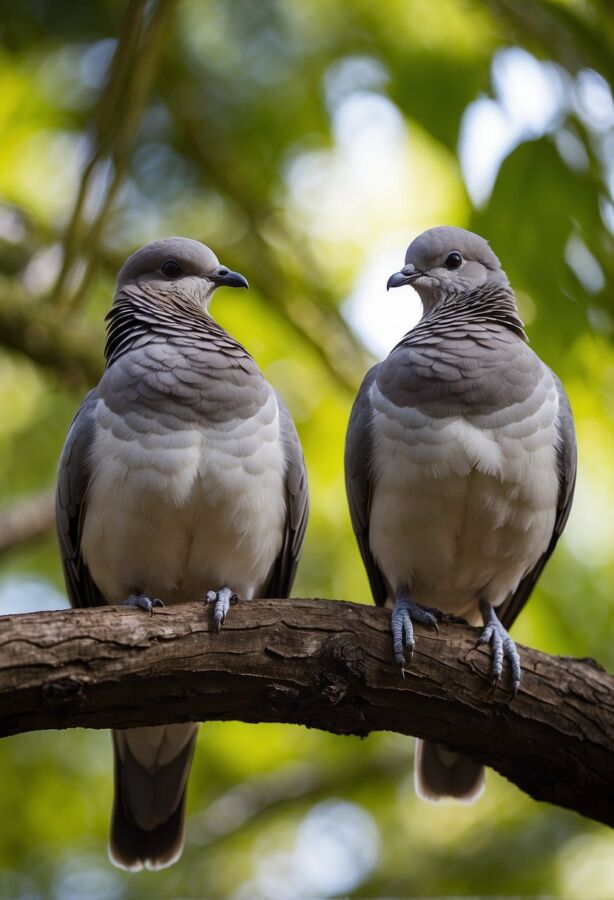
Doves are a group of birds within the family Columbidae, known for their stout body, short necks, and particularly soft, almost silky plumage. They differ from their counterparts, the pigeons, mainly in size, with doves being the smaller species.
Types of Doves:
- Mourning Dove: Widespread in North America, identified by its long, pointed tail.
- Rock Dove/Pigeon: Adapted well to urban environments.
- Eurasian Collared Dove: Notable for the black collar on the back of its neck.
- Inca Dove: Recognized by its scaled appearance.
Doves are often symbols of peace and have a calming presence, accentuated by their soft cooing calls. Their role in various ecosystems is undervalued, as they are important seed dispersers.
Conservation efforts are crucial for those species facing habitat loss. Maintaining this balance is pertinent, as it ensures these small yet significant members of the avian community continue to thrive.
Hen
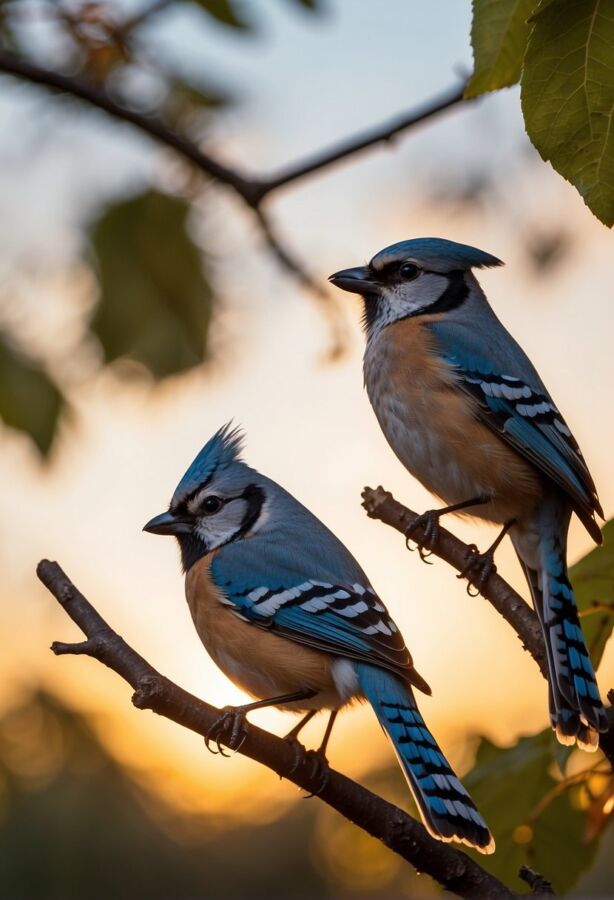
Hens, the female counterparts of roosters in the bird category, play a pivotal role in the egg production cycle and are primarily domesticated for this purpose. The term “hen” usually refers to a mature female bird, particularly in domestic chickens.
- Temperament: Varies by breed; generally social with complex social structures.
- Egg Production: Begins around six months of age, with breeds like the Ameraucana known for their distinctive light blue eggs.
Characteristics:
- Weight: Breed-dependent, e.g., 4-5 lbs for Araucana.
- Appearance: Diverse; Araucana lacks tail and has ear tufts.
Conservation:
- Status: Mostly not at risk due to domestication; certain heritage breeds may require conservation.
With particular attention to their breeding and care, hens contribute significantly to both backyard farming and large-scale agricultural operations. They are selected for various attributes, including temperament, egg-laying abilities, and physical characteristics.
Nightingale

The Nightingale (genus Luscinia) is a notable songbird renowned for its tuneful and extensive repertoire. Often heard at night, these birds’ songs blend trills, whistles, and gurgling sequences.
Characteristics:
- Size: 15-16.5 cm long
- Weight: 18-23 g
- Wingspan: 20-24 cm
- Appearance: Brown upperparts, reddish tail, buff to white underparts
Habitat & Distribution:
- Regions: Europe, Asia, Africa
- Habitats: Dense bush, woodland
Diet:
- Insects
- Fruit
- Seeds
Conservation Status:
- Least Concern
The Nightingales’ ability to produce a variety of vocalizations establishes them as a symbol of musical and poetic inspiration. Despite their current Least Concern conservation status, habitat loss and environmental changes pose threats, making continuous monitoring essential.
Eagle
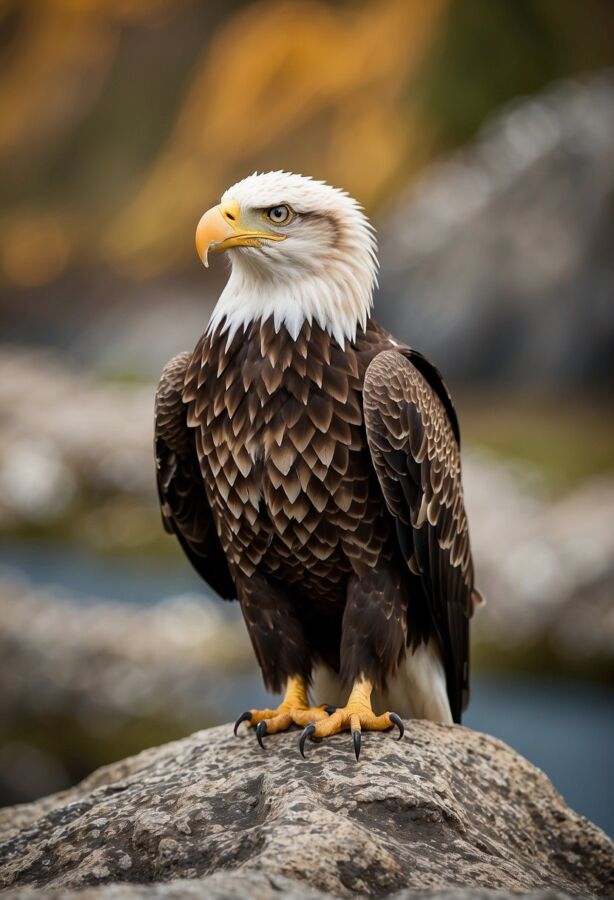
Eagles are large birds of prey renowned for their formidable size and powerful flight capabilities. They belong to the family Accipitridae and exhibit a distinctive feature known as “boots,” with feathers covering their legs to the feet. Eagles are expert hunters, often feeding on a variety of prey, including fish, small mammals, and other birds.
- True Eagles: Genus Aquila
- Sea Eagles: Including White-bellied Sea-eagle
- Snake-eagles: Known for hunting reptiles
- Other Species: Notably, the Harpy Eagle
The conservation status of some eagle species varies. For example, the majestic Harpy Eagle faces declining populations due to habitat loss and other human-driven factors. Conservationists emphasize the importance of protecting eagle habitats to maintain biodiversity and balance.
Swan

Swans, belonging to the Anatidae family, embody elegance on the water with their long necks and heavy bodies. These birds prefer aquatic environments and are notable for their graceful swimming.
Swan Species:
- Trumpeter Swan
- Tundra Swan
- Whooper Swan
- Black Swan
- Black-Necked Swan
- Mute Swan
Characteristics: Swans are among the largest waterfowl and maintain lifelong pair bonds. They are primarily white, except for the Black and Black-Necked Swans.
Habitat: Found globally, swans inhabit various waters, from ponds to coastlines. They migrate seasonally, especially in colder regions.
Conservation: While some species, like the Mute Swan,, are abundant, others, like the Trumpeter Swan, have faced threats, leading to conservation efforts to protect these avian icons.
Penguin

Penguins are a group of aquatic, flightless birds that live primarily in the Southern Hemisphere, with a notable concentration in Antarctica. These birds have evolved for life in the water, with wings modified into flippers ideal for swimming.
- Family: Spheniscidae
- Wings: Flippers
- Plumage: Countershaded dark and white
The species range in size from the little blue penguin to the emperor penguin, which is the tallest and most recognizable species endemic to the Antarctic region.
Conservation Status:
These birds are highly adapted divers, capable of deep and extended periods underwater while hunting for prey. Despite their proficiency in the ocean, penguins come ashore for breeding and molting. They face threats from climate change and overfishing, which impact their food sources and nesting grounds. Conservation efforts are vital for their survival as several species’ populations decline.
Flamingo

Flamingos are a distinctive group of wading birds belonging to the family Phoenicopteridae. They are readily identifiable by their vibrant pink color, which results from carotenoid pigments in their diet of algae and crustaceans.
Physical Characteristics:
- Coloration: Ranges from pale pink to crimson, influenced by diet.
- Legs: Long, stilt-like legs adapted for wading in water.
Species Distribution:
- Americas: Four species, including the Caribbean.
- Afro-Eurasia: Two species.
Notable Species:
- Phoenicopterus roseus – Greater flamingo
- Phoeniconaias minor – Lesser flamingo
Conservation:
Conservation efforts are crucial, as some species face threats from habitat loss and environmental changes. Preserving wetland ecosystems supports flamingos and a diversity of wildlife.
Goose

Geese, belonging to the family Anatidae, are waterfowl known for their seasonal migration in V-shaped flocks. Birds in this group exhibit strong migratory behaviors, often traversing vast distances between breeding and wintering grounds.
Species such as the Ross’s Goose breed in northern Canada and migrate to the United States for winter, preferring marshes during this season. The Brant Goose utilizes Arctic coastal regions for breeding, traveling to US coastlines and other areas across the globe in colder months.
Conservation efforts are important, as some species face various levels of threat due to habitat loss and environmental changes. Initiatives often focus on protecting migratory pathways and breeding grounds to sustain healthy populations.
Cuckoo

Cuckoos are a diverse group belonging to the order Cuculiformes. They are known for their distinctive calls and range of species, totaling over 140. Notably, several engage in brood parasitism, laying eggs in the nests of other bird species.
Nesting Habits:
- Brood parasites: Common cuckoo (Cuculus canorus)
- Build own nests: Coucals, some malkohas
Key Features:
- Size: Varied; coucals can rival the size of a large hawk
- Plumage: Generally, duller colors to intricate patterns
- Diet: Omnivorous; insects, fruit, small vertebrates
Cuckoo species have adapted to an array of habitats worldwide. Conservation efforts are vital for some species, while others maintain stable populations. The balance of their ecological roles and human-imposed threats dictates their conservation status.
Owl

Owls are nocturnal birds of prey with a reputation for being formidable hunters. These birds possess keen vision and hearing abilities, ideal for detecting prey in the dark—the facial discs of an owl act like acoustic radars, channeling sounds to their ears. Owls can rotate their heads up to 270 degrees, an adaptation that compensates for their fixed-eye sockets.
There are about 19 to 23 owl species in the United States, showcasing diversity in size and habitat preferences. Owls range from the small Elf Owl to the large Great Gray Owl. Here’s a breakdown:
- Elf Owl: The smallest North American owl adapted for life in the desert.
- Great Gray Owl: Noted for its massive size and powerful presence in forest areas.
Owls’ nocturnal activity and cryptic plumage often render them unseen during the day, but their vocalizations at night reveal their presence in various ecosystems. As top-level predators, they play a critical role in maintaining the balance of their habitats. Most species currently hold a “Least Concern” conservation status, but habitat loss and human activities continue to pose threats.
Hawk
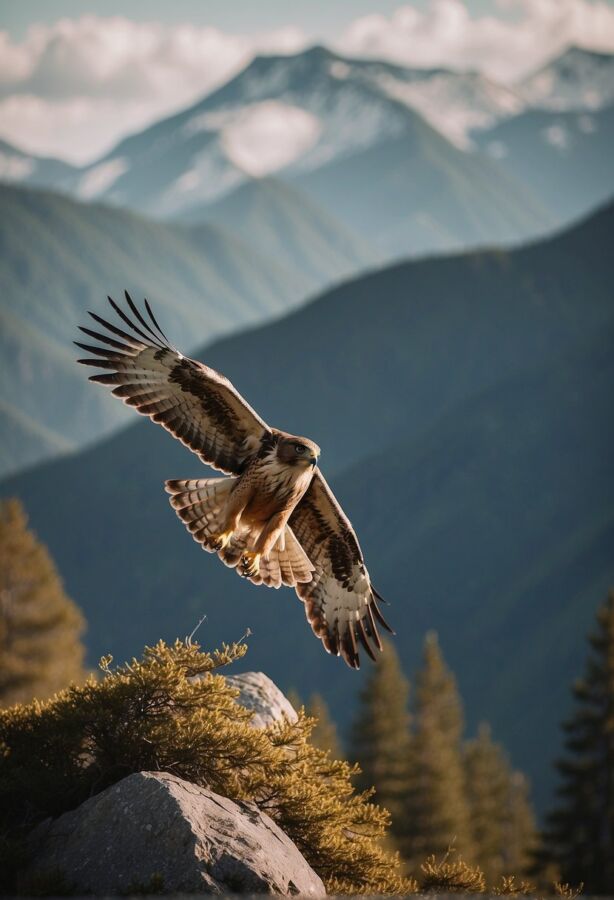
Hawks are a group of medium-sized diurnal birds of prey known for their sharp vision and agile flying skills. Belonging to the family Accipitridae, they have hooked beaks, strong talons, and exceptional eyesight, which is crucial for locating prey from a distance.
Types of Hawks:
- Buteos: Larger hawks with broad wings, soaring in open spaces.
- Accipiters: Smaller, forest-dwelling, known for their speed.
Notable Species:
- Red-tailed Hawk
- Sharp-shinned Hawk
- Cooper’s Hawk
Hawk Vision:
- Up to 8 times sharper than humans.
- Can detect ultraviolet light.
Conservation:
Many hawk species are stable, but some face habitat loss and pesticide threats. Conservation efforts focus on protecting habitat and reducing chemical exposure.
Hawks play a vital role in maintaining ecological balance, controlling rodent populations, and as indicator species for environmental health.
Partridge
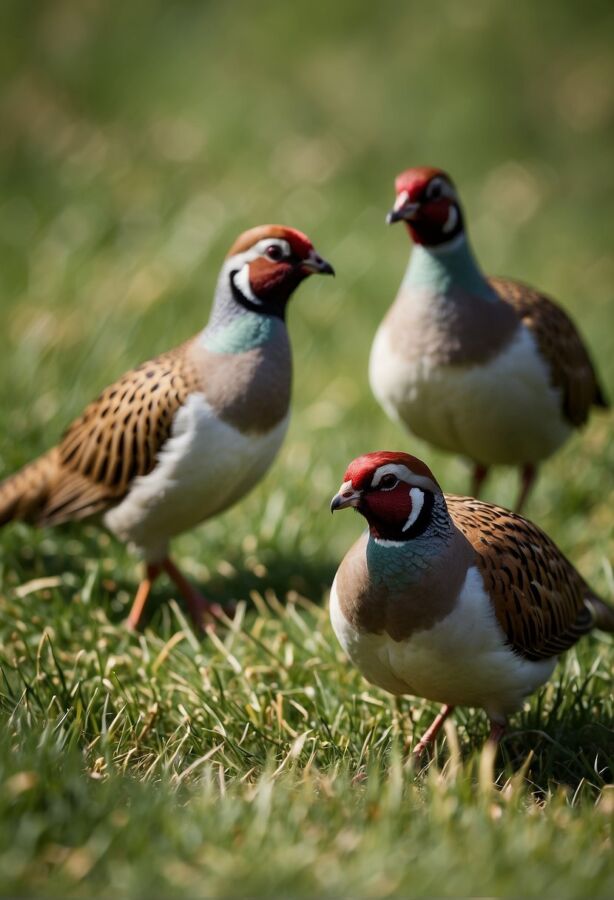
Partridges are medium-sized, ground-dwelling birds belonging to several genera within the Phasianidae family. These birds are often characterized by their plump bodies and small heads, resembling chickens in shape.
Characteristics:
- Size: Approximately a foot in length
- Weight: Roughly one pound
- Lifespan: Around 3 years in the wild
- Plumage: Grey, tan, white, and black are common colors
Species Distribution:
- Grey Partridge: Perdix perdix
- Daurian Partridge: Perdix dauurica
- Tibetan Partridge: Perdix hodgsoniae
Partridges are native to Europe, Asia, Africa, and the Middle East. Although adaptable, they prefer habitats with low vegetation that offer food and protection. As omnivores, their diet includes seeds, insects, and various small creatures. They are known for their distinct call, often used by males to attract mates or proclaim territory.
Conservation Status:
The species’ status varies, but many partridge populations face pressures from hunting and habitat loss. Conservation efforts are crucial to protecting their habitats and ensuring their survival.
Goldfinch
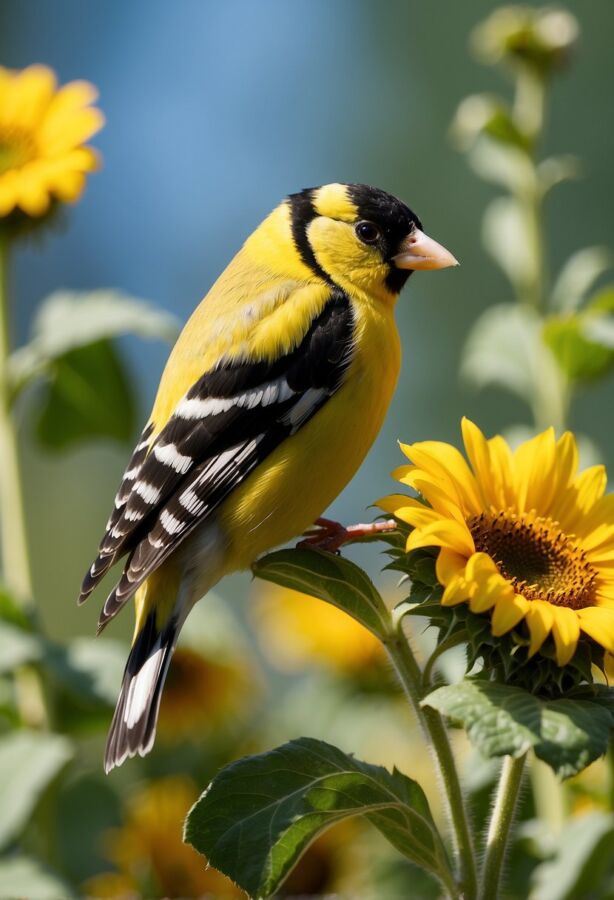
Goldfinches, small passerine birds in the finch family, exhibit vibrant yellow and black plumage, especially during breeding season. In the United States, there are three distinct species:
- American Goldfinch (Spinus tristis)
- Lesser Goldfinch (Spinus psaltria)
- Lawrence’s Goldfinch (Spinus lawrencei)
American Goldfinch: Recognized by its bright yellow body and contrasting black cap, this species undergoes a dramatic molt to a duller color in winter.
Lesser goldfinch males can have either a black or greenish back, while females are generally duller. Lawrence’s goldfinch has a distinctive grey and muted yellow coloration without the striking black cap. Its habitat preference ranges from weedy fields to backyards. These birds often flit about acrobatically, extracting seeds from flower heads.
Habitat and Behavior:
- Prefers open and partly wooded areas.
- Exhibits a bouncy, undulating flight pattern.
- Agile foragers, feeding on seeds and insects.
Conservation Status:
- Widespread; currently not threatened.
- Populations are subject to fluctuations due to habitat changes.
Goldfinches play a role in seed dispersal, contributing to the health of their ecosystems.
Robin
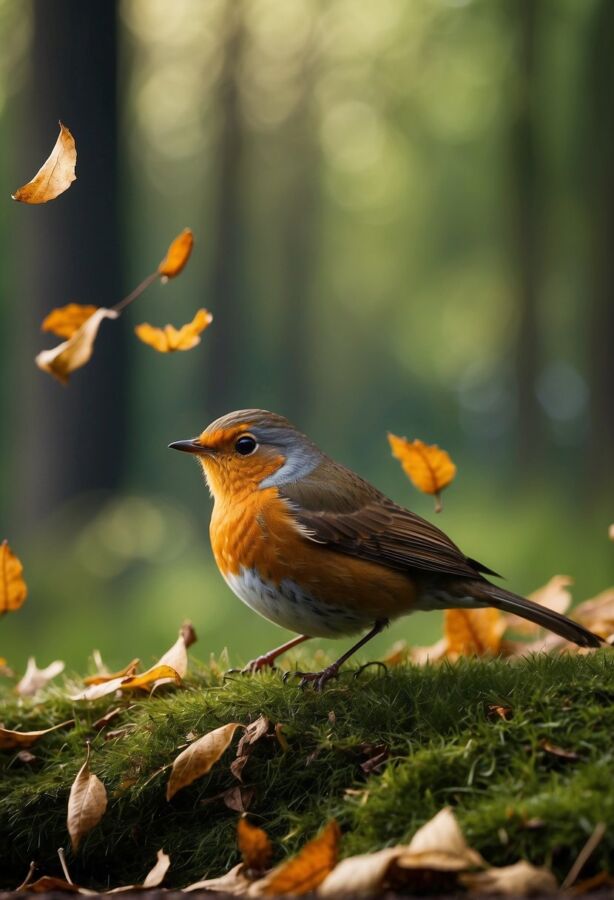
Robins are a common sight in gardens across North America and are celebrated for their cheerful presence. Known scientifically as Turdus migratorius, they belong to the Thrush family, Turdidae. These birds are easily identifiable by their round bodies, gray-brown feathers, and, notably, a rusty red underbelly.
Appearance
- Body: Round with a warm tone.
- Plumage: Grayish-brown with a distinct rusty-red belly.
Habitat
Robins adapt well to various environments but are commonly found foraging on lawns or nestlings on porches.
Behavior
- Feeding: Enjoys tugging earthworms from the soil.
- Song: Known for its rich caroling, a delightful dawn chorus.
Conservation
The American Robin is not at risk, benefiting from a wide distribution and varied habitats.
Kiwi
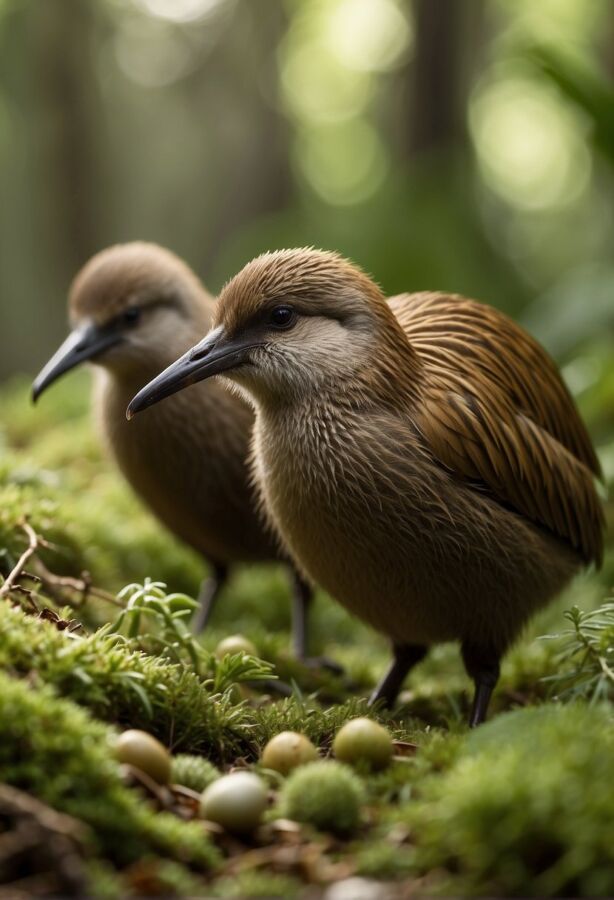
Kiwi birds, belonging to the genus Apteryx, are unique to New Zealand and are renowned for being flightless with shaggy feathers and a long beak. There are five recognized species, each with distinct characteristics:
- Great Spotted Kiwi (A. haastii)
- Little Spotted Kiwi (A. owenii)
- Brown Kiwi (A. australis)
- Rowi (A. rowi)
- North Island Brown Kiwi (A. mantelli)
Conservation Status:
Kiwi populations are under threat, with an estimated 70,000 individuals remaining. They are declining due to habitat loss and predation by invasive species.
Kiwis are nocturnal and have highly developed senses, especially their sense of smell. They lay one of the largest egg-to-body weight ratios of any bird. These remarkable traits and their importance to New Zealand’s natural heritage underscore the significance of Kiwi conservation efforts.
